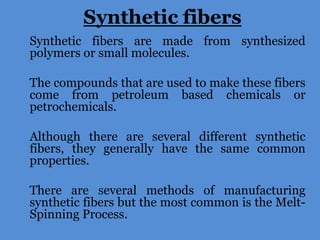
SYNTHETIC FIBRES
- 1. Synthetic fibers Synthetic fibers are made from synthesized polymers or small molecules. The compounds that are used to make these fibers come from petroleum based chemicals or petrochemicals. Although there are several different synthetic fibers, they generally have the same common properties. There are several methods of manufacturing synthetic fibers but the most common is the MeltSpinning Process.
- 2. Nylon • Is an artificial polymer belonging to the group of polyamides. Is formally generated by the polycondensation of a diacid with a diamine. • Nylon is a resilient and resistant textile fiber, not the moth attacks, requires no ironing. • It can take many forms but the two best known are the rigid and fiber
- 3. Polyster • Polyester is a category of polymers which contain the ester functional group in their main chain. • Natural polyesters and a few synthetic ones are biodegradable • Depending on the chemical structure, polyester can be a thermoplastic or thermoset. • Polyesters include naturally occurring chemicals, such as in the cutin of plant cuticles, as well as synthetics through step-growth polymerization such as polycarbonate and polybutyrate.
- 4. Origen del poliester En la década de los años treinta, se produjo en Inglaterra la primera fibra de poliéster, filamento contínuo, obtenido a partir de ácidos dicarboxílicos llamado Terylene ; en Francia esta fibra se llamó Tergal y en España Terlenka. Después de la segunda guerra mundial, la firma alemana Hoechst, empezó a producir un poliéster con el nombre de Trevira. En 1946 Du Pont adquirió la exclusiva para fabricar poliéster en Estados Unidos, conociéndose en aquél país con el nombre de Dacrón, y lanzado en 1951.
- 5. ORIGEN DE LA LYCRA Inventada en 1959 por el químico Joseph Shivers, quien trabajaba para la compañía DuPont. La empresa española DuPont patentó su invención en 1959 y le dio el conocido nombre de marca LYCRA. La fibra LYCRA es hoy propiedad de la empresa Invista. No es un tejido sino una de las fibras que componen un tejido. Sus propiedades son de dar elasticidad y mayor calidad que otros elastanos. Cuando se introdujo por primera vez, el elastano revolucionó muchas áreas de la industria textíl. Hoy en día es utilizado sobre todo en el ámbito deportivo gracias a su flexibilidad y ligereza. Es un polímero de cadena muy larga, compuesto con un mínimo del 85% depoliuretano segmentado (Spandex); obteniéndose filamentos continuos que pueden ser multifilamento o monofilamento.
- 6. ORIGEN DEL NAILON El descubridor del nailon y quien lo patentó por primera vez fue Wallace Hume Carothers. Lo descubrió el día 28 de febrero de 1935, pero no lo patentó hasta el 20 de septiembre de 1938 (U.S. Patents 2130523, 2130947 y 2130948). A la muerte de Carothers, la empresa DuPont conservó la patente. Los Laboratorios DuPont, en 1938, produjeron esta fibra sintética fuerte y elástica, que reemplazaría en parte a la seda y el rayón.
- 7. ORIGEN DEL RAYÓN El rayón fue la primera fibra manufacturada; se produce a partir de un polímero que se encuentra en la naturaleza (celulosa), por tanto no es una fibra sintética, sino una fibra celulósica manufacturada y regenerada. La fibra era vendida como "seda artificial" hasta que en 1924 se adoptó el nombre "rayón", siendo conocida en Europa además por el nombre de "viscosa". Hasta los años 30 sólo se fabricaba rayón en forma de hilo, hasta que se descubrió que las fibras rotas que se desechaban en la producción de hilo valían para ser entretejidas. Las propiedades físicas del rayón no cambiarían hasta el desarrollo del rayón de alta tenacidad en los años 40. Posteriores investigaciones llevaron a la creación del rayón HWM o modal en los 50.1
- 8. SPECIFIC PROPERTIES AND USES Nylon: Its melt viscosity is very low. You can add nylon fiberglass to provide increased stiffness . It is a crystalline polymer and is thus very resistant. Nylon is soluble in phenol, cresol and formic acid. Its melting point is 263 ° C. The nylon is used, for example, to make socks, sleepwear, underwear, blouses, shirts and raincoats.
- 9. • Polyester: It is absorbent. Retains heat better than linen. Resistant to acids, alkalis and bleaches. It has lots of shine. 50% crystalline. Very sensitive to thermodynamic processes. It is thermoplastic. Melting point = 250 ° C. Manufacture of beverage containers. Making pots in engineering, medicine, agriculture. Manufacture of toys, adhesives, dyes and paints. Manufacture of electrical and electronic components. Manufacture of adhesive tapes, tire reinforcement cords.
- 10. • Rayon: Rayon is a very versatile fiber and has the same properties in terms of ease of use than other natural fibers and can imitate the feel of silk, wool, cotton or linen. Rayon fabrics are soft, light, fresh, comfortable and highly absorbent, but not isolate the body, allowing perspiration. Rayon is mostly used in the textile clothing, in decoration, in industry and other uses.
- 11. • Lycra: Ability to stretch several times its size far and resume its original shape. It is lightweight, durable, easy to dye and resists abrasion and pressing. It also absorbs moisture naturally. The Lycra can be found in each category of the garment industry. The largest market segment is the exercise and training. It has also remained popular in both male and female underwear.